Laurie Accede
Laurie Accede
AP Art History 🖼
34 resourcesWhite Temple and its Ziggurat

Image Courtesy of Wikipedia
- Mud brick
- Religious architectural structure
- Worshippers would navigate through the terraces (similar to an outside porch area that was used for outdoor rituals) to access the temple to pray
- Not everyone as allowed to enter the ziggurat. The main visitors would be priests and people with some sort of power or privilege
- The structure has sloping sides and vertical bands that might have possibly been used for decoration
- Contains a cella, which was the innermost chamber within the temple that was used for worship
- This structure was located at Uruk, around 3200-3000 BCE
- One of the oldest ziggurat structures
- The ziggurat was located within the center of the city and it was an elevated structure to allow the deity to descend from the heavens
- The city was believed to have been protected by Anu, the god of the sky in Sumerian culture
Pallete of King Narmer

Image Courtesy of Khan Academy
- Graywacke
- Serves commemorative purposes to remind the people the King Narmer united Upper and Lower Egypt (narrative art)
- Also served ceremonial purposes as it was use to hold makeup
- The pallete uses hierarchy of scale to display King Narmer's authority. Hierarchy of scale is when the sizes of figures are in proportion to their importance (smaller figures are less important, bigger figures are more important).
- The pallete also uses registers, which separate art horizontally
- The Front of the Pallete
- The 1st register has the Goddess Hathor (the bat goddess)
- Shows King Narmer wearing the crown of Upper Egypt.
- He seems to be raising his hand to strike an enemy (demonstrating his ability as a warrior) .
- Horus (the Egyptian falcon god) is standing on papyrus holding a rope on his enemy’s head.
- The Back of the Pallete
- The 1st register has the Goddess Hathor (the bat goddess)
- King Narmer is displayed wearing the crown of Lower Egypt in the 2nd register next to his decapitated enemies;
- The 3rd register showing two mystical beasts with intertwined necks
- The 4th register shows a bull trampling an enemy (again possibly demonstrating King Narmer's ability to battle his enemies, but this time through symbolism)
- King Narmer unified upper and lower Egypt, forming the Old Kingdom
Statues of Votive Figures

Image Courtesy of Obelisk Art History
- Gypsum inlaid with shell and black limestone
- The statues are stylized, or with unique features meant to represent its owner (patron).
- The person would bring their statue to the ziggurat to pray for them in their absence
- Hands are folded in gesture of prayer
- HUGE, open eyes that represent eternal wakefulness (meant to demonstrate that the person will not stop praying)
- Hierarchy of scale- some statues are larger than others
- These statues are found from 2700 BCE Sumeria
- Hundreds have been found buried under the temples floor
Seated Scribe

Image Courtesy of Wikipedia
- Painted limestone with inlaid crystal eyes
- Funerary item- a ka (soul) statue that is supposed to hold the soul of the dead
- It was commissioned by the Pharaoh to honor the scribe's ability for writing and preserving Egyptian history.
- Pharaoh possibly also commissioned this statue so he can guarantee that this scribe accompanies him in the afterlife.
- Realistic, non-idealized sculpture (possibly demonstrating that the focus should be on the scribes intelligence and contribution to Egypt, not their physical image)
- The scribe is in a seated position with a papyrus ("Egyptian paper") scroll in his hand, and his writing instrument
- Buried in Saqqara, Egypt
Standard of Ur

Image Courtesy of Wikipedia
- Wood inlaid with shell, lapis lazuli, and red limestone
- Represents the accomplishments of the royals (narrative art)
- Can also possibly be funerary in nature since it was found in the royal tombs at Ur
- Uses registers and hierarchy of scale (the King is displayed slightly larger than the other figures, displaying his importance)
- Figures and animals are in twisted perspective (they are in unnatural posses)
- War Side: shows Sumerian warriors in armor trampling over their enemies and presenting the war captives
- Peace Side: a musician is playing a lyre while the King sits on the throne celebrating a feast with his attendants
- The various materials used for this piece reflects an extensive Sumerian trade network.
Great Pyramids (Menkaura, Khafre, Khufu) and Great Sphinx

Image Courtesy of AP Art History Go
- Limestone
- Pyramids are monuments that hold and preserve a Pharaoh's body
- The Sphinx is the supposed guardian of the pyramids. It is a symbol of royal power. (Cats were viewed as sacred in Egyptian culture)
- The pharaohs were respected as gods that were placed on Earth to lead the people. These kings were divine and the monuments also commemorate the king.
- The pyramids contained the king’s chamber and a mortuary temple for worship.
- The Sphinx was a composite human-animal figure; the head of a pharaoh and the body of a cat/lion.
- The pyramids are oriented to point towards the sun and are also modeled after ben-ben, both demonstrating reverence for Ra (the Egyptian Sun God)
King Menkaura and Queen
Image Courtesy of Art Authority
- Greywacke
- Funerary in function: a ka statue meant to hold and preserve the King and his Queen's soul
- Both figures are dressed in traditional royal attire.
- Both King Menkaura and the Queen are taking strides forward (which show a mutual respect for each other, as it was unusual for a women to take a stride). However, he seems to be taking a large step, indicting his position as leader in the relationship.
- Both figures are at a similar height, also demonstrating equality.
- The material used, greywacke, is a hard stone and is symbolic of the King's strength
The Code of Hammurabi

Image Courtesy of Wikipedia
- Basalt
- This stele shows Hammurabi’s power and authority
- It provides the world with the 1st written law code
- The sun god, Shamash, hands Hammurabi a measuring rod and rope as symbols of his authority
- The use of hiearchy of scale emphasizes the importance of Shamash. He is still slightly taller than Hammurabi, even while sitting; he also has a fuller beard.
- The stele is decorated with the laws written in cuneiform (ancient Sumerian language)
- Ancient Babylon
- This artifact follows the tradition of ancient leaders interacting with the gods and showing their society that they are meant to be gods representation on Earth.
- This stele also shows he shows that his laws have been blessed and approved by the gods
Temple of Amun-Re and Hypostyle Hall

Image Courtesy of The University of Memphis
- Cut sandstone and brick
- Religious center dedicated to the god Amun-Ra
- This was a temple for worship. Acess was restricted by class; only people of high status were allowed within the innermost chambers of the temple.
- Contains a hypostyle hall, which are tightly arranged columns. These columns resemble papyrus growing out of the Nile River.
- The innermost chamber encloses a well that is believed to be the birthplace of humanity
- This temple is located at Karnak, Egypt and was built over multiple generations, with each pharaoh making an addition
Mortuary Temple of Hatshepsut

Image Courtesy of Wikipedia
- Sandstone, partially carved into a rock cliff, and red granite
- This temple commemorates the achievements of Hatshepsut as a female pharaoh
- The temple is decorated with hieroglyphics
- Hatshepsut wearing traditional pharaoh attire, validating her rule
- She is holding canopic jars, which were used to hold intestines and body parts and she is kneeling and making an offering
- This is one of the first times in Art History where a woman and her honors are celebrated
Akhenaten, Nefertiti, and Three Daughters

Image Courtesy of World History Encyclopedia
- Limestone
- This artifact was found in a home, which possibly indicates that it was used for decoration
- It could have also been used to demonstrate the new Amarna style in Egypt
- Akhenaton is seated in the left holding one daughter, with Nefertiti on the right holding the other two daughters
- The sun's ray radiate on the family, and they have ankhs at the end (which are an Egyptian symbol representing everlasting life)
- King Akhenaton marked the beginning of the Amarna style in Egyptian art. During this period, King Akhenaton sought to change the polytheistic (multiple gods) Egyptian religion, to a monotheistic religion that solely worshipped Aton, the sun god.
Tutankhamun’s Tomb, Innermost Coffin
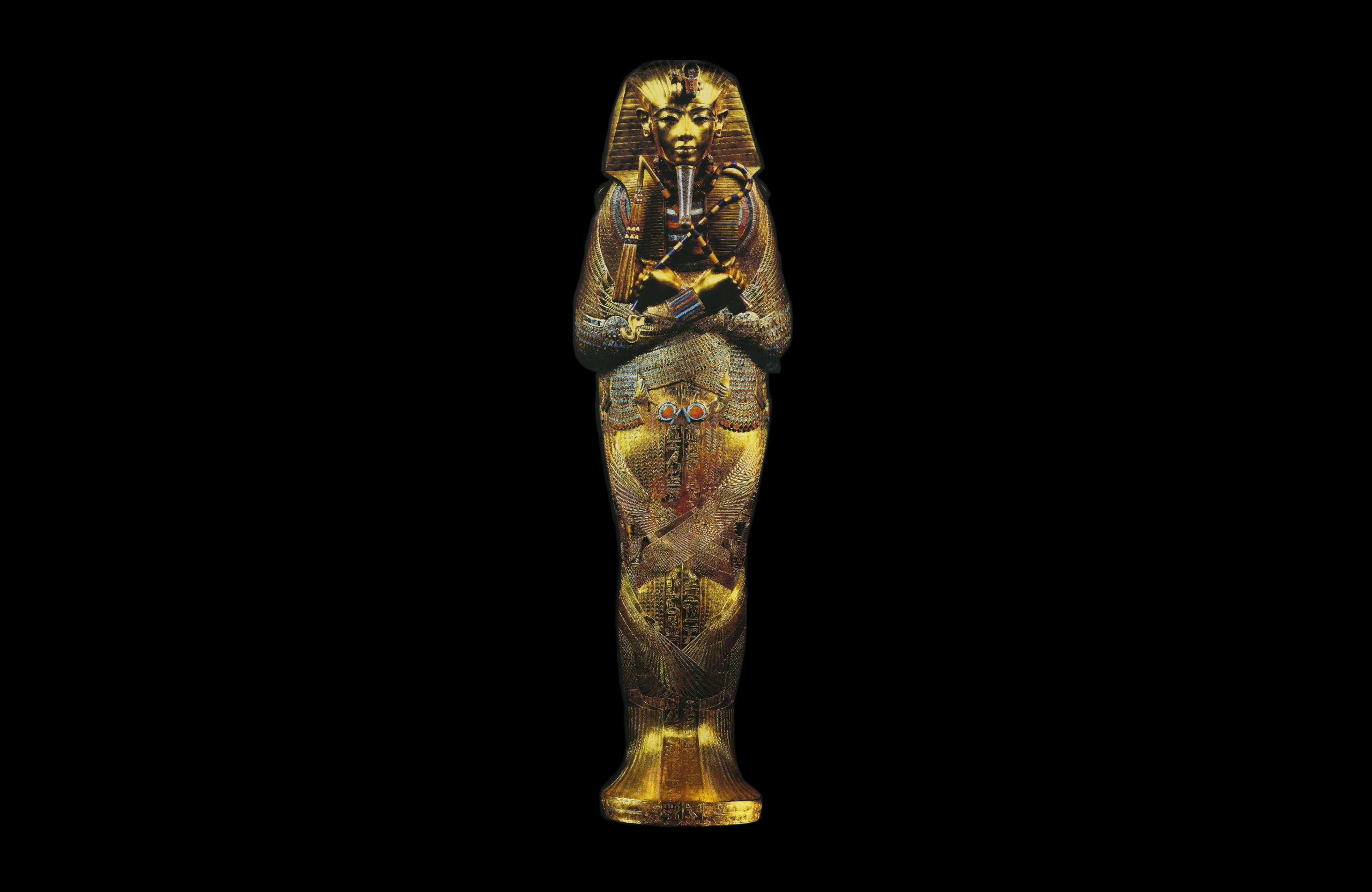
Image Courtesy of Smart History
- Solid gold with inlay of enamel and semiprecious stones.
- Coffin for King Tutankhamun’s body
- An idealized version of King Tutankhamun wearing traditional royal attire
- King Tutankhamun holds a crook and flail in his hands, crossed on his chest to symbolize his divine right to rule
- The ancient Egyptians would prepare the bodies of the Pharaohs in order to ensure their preservation in the after life
Last Judgement of Hunefer

Image Courtesy of Khan Academy
- Painted papyrus scroll
- Scroll depicts a narrative of Hunefer's journey on their way to the afterlife
- The scroll is divided into registers, and the figures are shown in twisted perspective.
- Hunefer, dressed in a white robe, is being judged by the gods to see if he is worthy of the afterlife
- Anubis, the jack-headed god of embalming, weighs Hunefer’s heart against a feather to see if he is worthy of the afterlife. If his heart weighs more than the feather, then it is full of sin and Hunefer is determined unworthy.
- Ammit, the composite animal figure, eats the heart if it is unworthy
- The god of writing, Thoth, writes down the events in hieroglyphics
- Osiris, the god of the underworld, will determine whether Hunefer is allowed to go into the afterlife on the day of judgement
- The Book of the Dead was an Egyptian book of spells that acted like a guide, or instructional manual to teach deceased people how to make their way into the afterlife.
Lamassu from the Citadel of Sargon II,

Image Courtesy of Khan Academy
- Alabaster
- The Lamassu stand at the gate of a fortified city and are meant to act as the kingdom’s guardians, intimidating and warding off enemies
- This also symbolizes the king's power
- 5-legged, winged composite animal-human figure
- The Lamassu is from the citadel of Sargon around 720 BCE
- The Assyrians often praised and honored their king, and these works reflect the warring nature of the kingdom.
Athenian Agora

Image Courtesy of AP Art History Go!
- Plan
- The buildings are made from marble
- This was an agora, or a civic center
- Various structures and buildings
- Temples that honored gods
- Stoas, or walkways with columns
- Tholos where government officials (senators) held meetings
- A Panathenaic Way was used during the Pantheon processions
- Boules, or a council of people, would complete tasks at the bouleuterion
- The Athenian agora was located in Athens from 600 BCE to 150 CE
Anavysos Kouros

Image Courtesy of Wikipedia
- Marble with remnants of paint
- Used as a grave marker
- Completely nude, idealized statue of a kouros (young boy)
- Freestanding body stance
- Characteristic archaic smile
- This statue is from the Archaic period in Greek art
- Demonstrated the Greek philosophy of humanism which sought to recreate reality and reflect the human being
Peplos Kore

Image Courtesy of Wikipedia
- Marble with painted details
- Could have possibly been used as a grave marker or for religious purposes
- Idealized statue of a kore (young girl) with one arm extended
- The girl is wearing a peplos, a traditional dress
- Characteristic archaic smile
- The statue is from Acropolis, a city that was built on a city on a mountain in honor of the Gods
Sarcophagus of the Spouses

Image Courtesy of Wikipedia
- Terra cotta
- A sarcophagus was a coffin that held the remains of both the husband and wife
- Displays a married couple, with the wife in the front and the husband in the back.
- They seem to be holding objects
- The artwork demonstrates a mutual respect between men and women in Estrucan society
- The reclining nature of the couple, with wineskins symbolize the sharing of wine during ceremonies and funerary rituals
Audience Hall of Darius and Xerxes
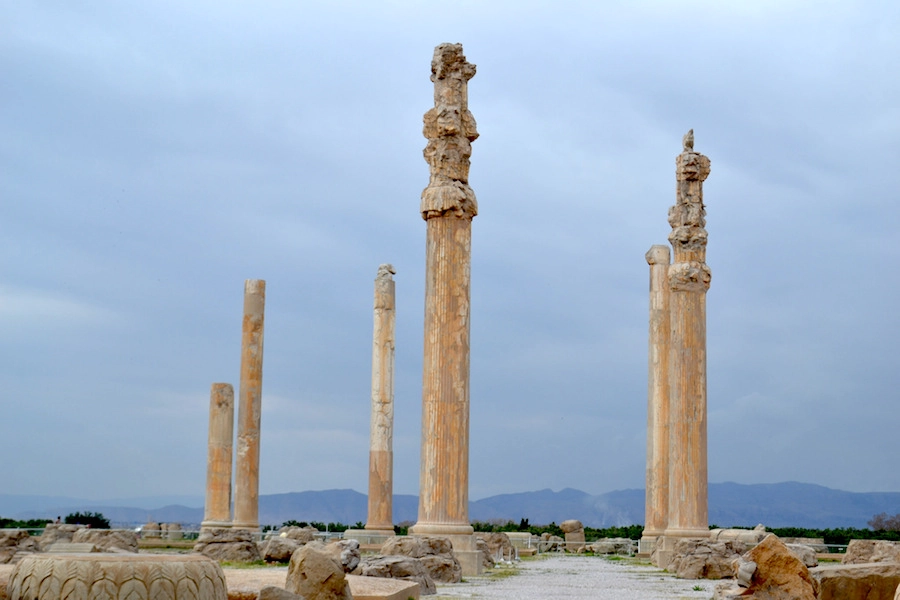
Image Courtesy of Smart History
- Limestone
- An architectural site built to demonstrate the power and wealth of the Persian Empire
- It was used by all civilians to gather for social events and watch entertainment
- Decorated with relief sculptures such as the fighting lions, which are a tradition used by Kings to demonstrate their braveness
- 72 intricate columns across the audience hall
- The audience hall, or apadana was started by King Darius and finished by his son Xerxes
- The location was named "Persepolis" after Alexander the Great sacked the structure and the Greeks conquered Persia
Temple of Minerva and Sculpture of Apollo

Image Courtesy of AP Art History Go!

Image Courtesy of Smart History
- The temple is made from wood, mud brick, and tufa (volcanic rock)
- The sculpture is made from terra cotta
- The temple was dedicated to the goddess Minerva
- The sculpture was place at the top of the temple, possibly for decoration
- The temple is divided into three cellas (interior room) for the worship of gods
- The statue is wearing tightly fitted garments, and has an archaic smile, similar to those of Greek sculptures
- The Estruscan artwork was inspired by Greek architecture and sculpture.
- The Apollo artifact is believed to have been sculpted by Vulcan of Veii
Tomb of the Triclinium

Image Courtesy of Wikipedia
- Tufa and fresco (paint on wet plaster)
- A tomb hold the deceased and other ritual objects.
- The artwork that decorates the tomb possibly details a lively event
- Across the artwork, there are people dancing and celebrating
- Many Etruscan funerary items depict the common theme of how the Etruscan viewed the afterlife like a celebration. The figures in the work can also be seen having a banquet, possibly consuming wine. There are also reclining couples similar to the Sarcophagus of Spouses.
Niobides Krater

Image Courtesy of AP Art History Go!
- Kraters were used by the Ancient Greeks to mix water and wine
- The decoration on the krater displaces a story in Greek mythology (narrative art)
- One side of the krater displays the Greek story of Artemis (the goddess of hunting and the wild) and Apollo (the god of music) killing Niobides and her children
- The content on the other side of the krater is largely debated, but it is said to show Hercules and Athena (the god of wisdom) having a discussion
- The krater was found in Italy, indicating that is was possibly traded
- For more context on the Greek mythological story: Niobides was a woman with 14 children who bragged about her fertility to the god Leto. Leto sought revenge and sent their children, Apollo and Artemis, to kill Niobides' children.
Doryphoros (Spear Bearer)

Image Courtesy of Art in Context
- The original sculpture was made out of bronze, but the Roman copy is made from marble.
- This sculpture does not have a clearly, defined function. It primarily marks a transition from Archaic sculpture to Classical style sculptures.
- An idealized, free-standing nude man
- The sculpture of Doryphoros was Polykleitos. He was a Greek mathematician who invented contrapposto.
Acropolis

Image Courtesy of AP Art History Go!
- Marble
- The Parthenon was built to house the statue of Athena
- The Temple of Athena Nike (Nike was the goddess of victory) commemorates the Greek victory over the Persians at the Battle of Marathon.
- The Nike sculpture, Plaque of Ergastines, the Elgin Marbles (Helios, Horses, and Dionysus) are primarily decorative pieces.
- The Parthenon contains a combination of doric and ionic columns. There are friezes (horizonal decorative panels) that display numerous historical events.
- The Temple of Athena Nike contains ionic columns with friezes that display scenes of victory.
- The statue of winged-goddess Nike adjusting her sandal uses wet drapery, which is when the clothing clings to the figures body.
- The Plaque of Ergastines show six young women who are preparing for the Panathenaic Festival that is held in honor of Athena. The women are responsible for weaving Athena’s peplos.
- The Elgin Marbles use the contrapposto technique to show Dionysus, the god of wine and Helios, the sun god, with his horses which he uses to control sunrise and sunset
- Acropolis contains artistic style from the Classical Period in Greek Art.
- Acropolis was in Athens, Greek and was built on top of a hill/mountain.
Grave Stele of Hegeso

Image Courtesy of Wikipedia
- Marble with paint
- A grave marker that commemorates the death of Hegeso
- Hegeso is seated, examining jewelry presented to her by a servant
- This grave marker resembles a modern-day tombstone, this contrasts with the previous Greek grave markers in this Unit like the Anavysos Kouros.
- This stele is from the Classical Greece period, around 410 BCE
Winged Victory of Samothrace

Image Courtesy of Wikipedia
- Marble
- This is a monumental figure that commemorates a naval victory during Alexander the Great's reign
- Because the sculpture was attached near the front of the ship, it might have also been placed to protect the sailors
- Displays winged Nike, the goddess of victory
- The various techniques used include wet drapery and contrapposto
- The statue is extremely damaged although there are attempts at reconstruction, and some detached parts of the statue have been found.
- This statue is from the Hellenistic Period.
Great Altar of Zeus and Athena at Pergamon
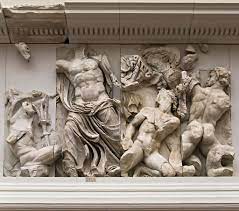
Image Courtesy of AP Art History Go!
- Marble
- Demonstrates the monumental importance of Athena's victories
- The image depicts the Gods (especially Athena) defeating the Giants
- The Giants are depicting with emotion: pain and anguish.
- Nike crowns Athena with victory
- The Gods' victory is meant to parallel Alexander the Greats' victory over the Persians. This legitimized Alexander the Great's ability as a warrior.
House of the Vettii

Image Courtesy of The Smithsonian Magazine
- Cut stone and fresco
- The House of Vetti as the name suggests, was a home. It displayed the wealth of the Vetti family.
- Contained an atrium, which collected rain water for use
- The house contained only one narrow entrance. It also lacked windows, but it did have multiple bedrooms
- The home was decorated with fresco paintings in 4th style, which combined many different motifs and features.
- The house was built by the wealthy Vetti family during Imperial Rome.
Alexander Mosaic

Image Courtesy of AP Art History Go!
- Mosaic (arranged small pieces of material)
- This mosaic was used as flooring and depicts a historical event
- The mosaic displays Alexander the Great and Darius III fighting at the Battle of Issus.
- Alexander the Great is shown piercing his enemies with a spear and Darius III retreats
- This is another art-work in this unit that depicts Alexander the Great as a powerful conqueror, and specifically depicting his victory over the Persians.
Seated Boxer

Image Courtesy of AP Art History Go!
- Bronze
- There is no defined function for this sculpture, but is was possibly a good luck charm for athletes
- This is a boxer after a fight, seated with his boxing gloves and cuts and bruises across his body
- The boxer expresses deep emotion, possibly of exhaustion and/or sadness
- This is a rare bronze, sculpture; most Greek sculptures from this unit are made from marble
- The sculpture is from Hellenistic Greece, and follows the tradition of an idealized and perfect human body, with a facial expression of emotion
Head of a Roman Patrician
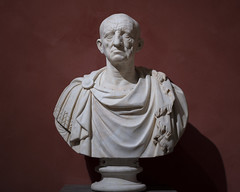
Image Courtesy of Smart History
- Marble
- These busts (sculpture of a head and shoulders) were commissioned by Roman aristocrats to be placed in their homes.
- An extremely realistic face, known as veristic style, with a serious facial expression, furrowed brow, and wrinkles
- The person displayed is a patrician, or Roman aristocratic.
- The sculpture embraces wrinkles and "signs of oldness," because they are all signs of experience and wisdom. A ancient Roman ideal was virtue and seriousness, which are displayed in the expressions of the patrician
Augustus of Prima Porta

Image Courtesy of Smart History
- Marble
- This sculpture was possibly used as a form of propaganda, in order to support Augustus' power and authority and emperor, and to show him as a heroic figure.
- A young, athletic idealized sculpture of Augustus of Prima Porta dressed in traditional military attire.
- He is pointing his finger, as if he is directing and army or designating tasks
- Augustus is barefoot in order to suggest that he is standing on sacred ground
- Cupid (the god of love) stands at the base of the sculpture
- Augustus was the first emperor of Rome, and he marked the beginning of Rome's domination and influence on the world.
- While this is a Roman artifact, contrapposto is present in the sculpture, indicating the influence of the Greeks on Roman art.
Colosseum (Flavian Amphitheater)

Image Courtesy of Wikipedia
- Stone and concrete
- A large stadium that was used for public entertainment (typically gladiator battles)
- Repetitive arches and engaged columns (includes the use of all three Greek orders- Doric, Ionic, and Corinthian)
- There was an area under the amphitheater that would house animals, slaves, and other items that were used for the shows/battles
- The name "Colosseum" comes from the giant statue of Nero that used to be next to the amphitheater
- Similar to modern times, seating closer to the arena was more expensive, the seating farther from the entertainment. Furthermore, seating was divided by social class and status.
- This architectural structure was also inspired by Greek theaters, and the presence of the Greek orders also demonstrates Greek influence
Forum of Trajan

Image Courtesy of Smart History
- The architecture was made from brick and concrete.
- The Column of Trajan was made from marble
- A forum is a large, open public space.
- Civilians can go to markets to buy and sell items.
- There were also courts for judges, and specialized areas for the emperor and politicians.
- The forum of Trajan might have also been built to commemorate Trajan's success as emperor
- The column of Trajan was possibly a grave marker
- Forum: large entrance way filled with sculptures and carvings that display historical narratives
- Market: multi-story with many different shops
- Column of Trajan: carved art decorates the column. They depict scenes from Trajan's Dacian Wars.
- Trajan's ashes were placed at the bottom of the column.
- The Dacian Wars were fought between the between the Roman Empire and Dacia during Emperor Trajan's rule. Trajan was determined to win the war after previous Roman emperor Domitian struggled to conquer Dacia.
Pantheon

Image Courtesy of Khan Academy
- Concrete with stone facing
- This was a Roman temple dedicated to all the gods
- Exterior: Corinthian capitals were used to hold up the structure
- Gutters on the floor to collect water because there was an oculus, which is a hole in the roof which allowed for sunlight
- Coffers were squares used to alleviate the weight of the concrete
- There were areas to hold statues of the gods
- The building is named "Pantheon," meaning "all the gods"
- The structure was originally commissioned by Marcus Agrippa and Emperor Hadrian later added revisions.
Ludovisi Battle Sarcophagus

Image Courtesy of Khan Academy
- Marble
- This was a funerary item, a sarcophagus which holds a deceased persons remains
- Ludovisi is in the center riding a horse and leading the Romans into battle
- Those around him are gladiators in the army
- The enemies are being trampled over
- Ludovisi was a Roman general
- The crowded nature of the sarcophagus (a technique known as horror vacui) reflects the chaos of war
- This is another idealized Roman art-piece that depicts the Romans as heroic and expands on the demonstration of the Romans as a strong military power


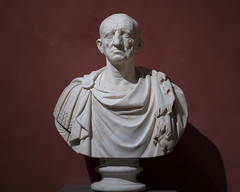
- White Temple and its Ziggurat
- Pallete of King Narmer
- Statues of Votive Figures
- Seated Scribe
- Standard of Ur
- Great Pyramids (Menkaura, Khafre, Khufu) and Great Sphinx
- King Menkaura and Queen
- The Code of Hammurabi
- Temple of Amun-Re and Hypostyle Hall
- Mortuary Temple of Hatshepsut
- Akhenaten, Nefertiti, and Three Daughters
- Tutankhamun’s Tomb, Innermost Coffin
- Last Judgement of Hunefer
- Lamassu from the Citadel of Sargon II,
- Athenian Agora
- Anavysos Kouros
- Peplos Kore
- Sarcophagus of the Spouses
- Audience Hall of Darius and Xerxes
- Temple of Minerva and Sculpture of Apollo
- Tomb of the Triclinium
- Niobides Krater
- Doryphoros (Spear Bearer)
- Acropolis
- Grave Stele of Hegeso
- Winged Victory of Samothrace
- Great Altar of Zeus and Athena at Pergamon
- House of the Vettii
- Alexander Mosaic
- Seated Boxer
- Head of a Roman Patrician
- Augustus of Prima Porta
- Colosseum (Flavian Amphitheater)
- Forum of Trajan
- Pantheon
- Ludovisi Battle Sarcophagus

© 2024 Fiveable Inc. All rights reserved.